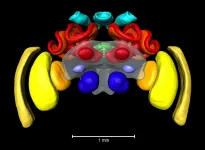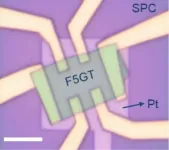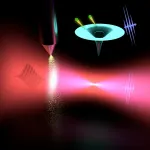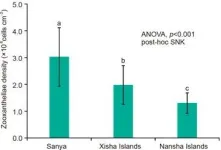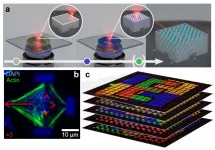A template for fast synthesis of nanographenes
New combined synthesis method an exciting breakthrough in the construction of nanographene libraries
2021-06-28
(Press-News.org) A group of researchers at Nagoya University, Japan, have developed a new method for quickly and efficiently synthesizing nanographenes, a type of nanocarbon with great potential as a next generation material.
Nanographenes are the part structures of graphene, which is a sheet of carbon atoms around 3 nanometers thick with particular potential for use in semiconductor development, having electron mobility several hundred times better than current generation materials. Graphene was first isolated in 2004, a discovery which received the 2010 Nobel Prize in physics, making it a very new material which is currently the subject of a great deal of research.
With magnetic and electric characteristics beyond those of graphene, nanographenes are equally of interest to scientists in the nanocarbon research field. The biggest obstacle, albeit an exciting one, faced by researchers is the sheer number of potential nanographenes. The number of potentially possible nanographene structures increases with the number of benzene rings (6 atoms of carbon in a hexagonal formation) to make them. For example, even a relatively small 10 benzene ring nanographene may have up to 16,000 variants. As each nanographene has different physical characteristics, the key to applied nanographene research is to identify the relationship between the structure and characteristics of as many nanographenes as possible.
Thus, scientists' task is to create a nanographene library, containing data on the properties of as many nanographenes as possible. However, the current method of nanographene synthesis, known as a coupling reaction, is a multi-step process which produces one single nanographene. Thus, to create a 100-nanographene library, 100 separate coupling reactions would have to be carried out. Even this would be a significant undertaking, rendering the construction of a truly comprehensive nanographene library practically impossible.
To solve this problem, the Nagoya University research group, led by Professor Kenichiro Itami, have been working on the APEX reaction, a reaction which uses polycyclic aromatic hydrocarbons as templates to synthesize nanographenes. Polycyclic aromatic hydrocarbons have three areas of their structure - known as the K region, M region and bay region - which can be elongated in an APEX reaction, producing three nanographenes. These nanographenes can then be further elongated in a second reaction, meaning that a large number of nanographenes can be synthesized from a single polycyclic aromatic hydrocarbon template molecule.
With Professor Itami's group having already developed the K region APEX reaction, and another group of scientists having done so for the bay region, they turned their attention to the M region. They activated the M region using the 1950 Nobel Prize winning Diels-Alder reaction, and succeeded in carrying out an elongation reaction on the activated M region, thus rendering all three possible sites on the polycyclic aromatic hydrocarbons capable of synthesizing nanographenes.
The researchers were able to produce 13 nanographenes with three APEX reactions, with most of these being previously unseen structures, thus proving both the efficiency and usefulness of this new method.
This exciting new piece of research and its potential to accelerate the creation of nanographene libraries is a step towards the development of the next generation of materials, which have the potential to revolutionize semiconductors and solar energy and improve lives all around the world.
INFORMATION:
[Attachments] See images for this press release:
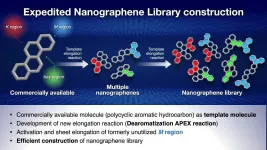
ELSE PRESS RELEASES FROM THIS DATE:
2021-06-28
The buff-tailed bumblebee Bombus terrestris is one of the most common bumblebee species in Europe. It is not only active in nature as a pollinator - humans also use it in greenhouses and foil tunnels to get good harvests of tomatoes or strawberries.
The buff-tailed bumblebee is also used in science: "Basic research is increasingly using it as a model organism to analyse learning and memory, the visual system, flight control and navigation abilities," says Dr. Keram Pfeiffer, Professor of neurobiology at the Biocenter of Julius-Maximilians-Universität (JMU) Würzburg in Bavaria, Germany.
Pfeiffer investigates the neuronal ...
2021-06-28
A RMIT-led international collaboration published this week has achieved record-high electron doping in a layered ferromagnet, causing magnetic phase transition with significant promise for future electronics
Control of magnetism (or spin directions) by electric voltage is vital for developing future, low-energy high-speed nano-electronic and spintronic devices, such as spin-orbit torque devices and spin field-effect transistors.
Ultra-high-charge, doping-induced magnetic phase transition in a layered ferromagnet allows promising applications in antiferromagnetic spintronic devices.
The FLEET collaboration of researchers at RMIT, UNSW, the University of Wollongong and FLEET partner ...
2021-06-28
The invention of the laser has opened the era of nonlinear optics, which today plays an important role in many scientific, industrial and medical applications. These applications all benefit from the availability of compact lasers in the visible range of the electromagnetic spectrum. The situation is different at XUV wavelengths, where very large facilities (so called free-electron lasers) have been built to generate intense XUV pulses. One example of these is FLASH in Hamburg that extends over several hundred meters. Smaller intense XUV sources based on HHG have also been developed. However, these sources still have a footprint of tens of meters, and have so far only been demonstrated at a few universities and research institutes worldwide. ...
2021-06-28
A naturally occurring peptide in sunflower seeds was synthetically optimised and has now been identified as a potential drug for treating abdominal pain or inflammation (in the gastrointestinal tract, abdominal area and/or internal organs). That is the finding of an international study led by Christian Gruber from MedUni Vienna's Institute of Pharmacology (Center for Physiology and Pharmacology), which was conducted jointly with the University of Queensland and Flinders University in Australia and has now been published.
The scientific aim of the study is to find analgesics that are only active in the periphery and do not cross the blood-brain barrier, as an alternative to commonly used synthetic opioids. Gruber explains the background: "Morphine was one of the first ...
2021-06-28
In a new scientific investigation headed by the German Leibniz Institute for Zoo and Wildlife Research (Leibniz-IZW), water from African and Mongolian waterholes as well as bloodmeals from Southeast Asian leeches were assessed for the ability to retrieve mammalian viruses without the need to find and catch the mammals. The scientists analysed the samples using high throughput sequencing to identify known viruses as well as viruses new to science. Both approaches proved to be suitable tools for pandemic prevention research as they allow finding and monitoring reservoirs of wildlife viruses. For example, a novel coronavirus most likely associated with Southeast Asian deer species was identified. The results are ...
2021-06-28
An international research team led by HKUST has developed a simple but robust blood test from Chinese patient data for early detection and screening of Alzheimer's disease (AD) for the first time, with an accuracy level of over 96%.
Currently, doctors mainly rely on cognitive tests to diagnose a person with AD. Besides clinical assessment, brain imaging and lumbar puncture are the two most commonly used medical procedures to detect changes in the brain caused by AD. However, these methods are expensive, invasive, and frequently unavailable in many countries.
Now, a team led by Prof. Nancy IP, Vice-President for Research and Development at HKUST, has identified 19 out of the 429 plasma proteins associated with AD to form ...
2021-06-28
University of Otago, New Zealand, and UK researchers have developed a world-first weight-loss device to help fight the global obesity epidemic.
DentalSlim Diet Control is an intra-oral device fitted by a dental professional to the upper and lower back teeth. It uses magnetic devices with unique custom-manufactured locking bolts. It allows the wearer to open their mouths only about 2mm, restricting them to a liquid diet, but it allows free speech and doesn't restrict breathing.
Participants in a Dunedin-based trial lost an average of 6.36kg in two weeks and were motivated to continue with their weight loss ...
2021-06-28
Coral bleaching and the ecological degradation of coral reefs have become increasingly severe due to the global warming and human activities. As "mixotrophic" organisms, scleractinian coral can not only obtain energy through photosynthesis of symbiotic zooxanthellae (autotrophy), but also ingest nutrients in seawater through the coral host (heterotrophy). However, the influence of coral's trophic flexibility on environmental adaptability remains unclear. Coral reefs are widely distributed in the South China Sea (SCS), spanning about 20 latitudes from north to south. The environmental conditions of coral reef areas at different latitudes are significantly different. ...
2021-06-28
Thousands of scientific papers describing the inner workings of the brain and its dysfunction have been published using resting state functional magnetic resonance imaging (RS-fMRI). This powerful tool allows researchers to look at each cubic millimeter of the brain, in voxels - the 3D version of a pixel. The average brain is well over 1,000,000 cubic mm, so researchers need to perform multiple comparisons correction (MCC) to reduce the possibility of making false claims, i.e., reduce the false positive rates. As part of this MCC, a smaller p value threshold is widely recommended for declaring ...
2021-06-28
Multi-photon approaches provide printing rates of up to about ten million voxels per second. And, multi-photon-based 3D approaches structure matter with a resolution approaching sub-micrometer and nanometer feature sizes. Such spatial resolution is crucial for many applications in photonics and electronics and is inaccessible to most other 3D additive manufacturing approaches. However, the vast majority of 3D printed objects and devices made along these lines has been composed of only a single polymeric material. Multi-material architectures are much less investigated ...
LAST 30 PRESS RELEASES:
[Press-News.org] A template for fast synthesis of nanographenes
New combined synthesis method an exciting breakthrough in the construction of nanographene libraries

